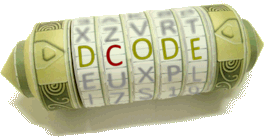Tool to decrypt/encrypt with SHA1 (Secure Hash Algorithm) with 40 characters (in hexadecimal) often used in cryptography.
SHA-1 - dCode
Tag(s) : Hashing Function, Modern Cryptography
dCode is free and its tools are a valuable help in games, maths, geocaching, puzzles and problems to solve every day!
A suggestion ? a feedback ? a bug ? an idea ? Write to dCode!
SHA-1
SHA-1 Decoder
SHA1 Encoder
SHA-1 Hash Search
Answers to Questions (FAQ)
What is SHA-1? (Definition)
SHA-1 (for Secure Hash Algorithm 1) is a cryptographic hashing algorithm developed by the NSA that transforms a variable-size data entry into a fixed 160-bit fingerprint (40 hexadecimal characters). This fingerprint is designed to be unique and deterministic: the same entry will always produce the same hash, this ensures the integrity of the initial data (a file or a message).
How to encrypt using Secure Hash Algorithm (SHA-1) ?
The SHA-1 algorithm takes a string of data and runs it through several processing steps (bit additions, chunking, logical operations, and rotations). The algorithm uses non linear functions, here are the 3 main ones:
$$ C(x,y,z) = (x \wedge y) \vee (\lnot x \wedge z) \\ P(x,y,z) = x \oplus y \oplus z \\ M(x,y,z) = (x \wedge y) \vee (x \wedge z) $$
With $ x,y,z $ portions of string to encode or fixed values among 0x67452301, 0xEFCDAB89, 0x98BADCFE, 0x10325476, 0xC3D2E1F0 (and others)
These operations are designed so that any change in the input results in a significant change in the fingerprint, making it difficult to predict the outcome.
Example: dCode is encrypted with the footprint 15fc6eed5ed024bfb86c4130f998dde437f528ee
How to decrypt a SHA-1 hash?
As encryption is a hashing based on nonlinear functions, there is no decryption method. This means that to retrieve the password corresponding to a sha-1 hash, there is no choice but to try all possible passwords!
Technically, this operation would take several thousand years, even on the most powerful computers in the world. However, the list of passwords used in real life is more restricted, and it becomes possible to precalculate the most likely fingerprints.
dCode uses its word databases (10 million potential passwords) to speed up this processing. However, if the password is rare, or combined with salting, it will probably not be found.
How to recognize SHA-1 fingerprint?
The hash is composed of exactly 40 hexadecimal characters among 0123456789abcdef.
More rarely the hash is stored as a 20-byte binary string.
What are the variants of the SHA-1 cipher?
The database search can be complicated by inserting a salt to the word. The salt is usually a prefix or a suffix. Indeed, if it is already difficult but possible to precalculate the fingerprints of all the words, it becomes even more difficult to precalculate with all possible prefixes and suffixes.
Example: SHA1(dCode) = 15fc6eed5ed024bfb86c4130f998dde437f528ee but SHA1(dCodeSUFFIX) = 9b63fcb31388acee8879018244a3d107033890f1
Another (not recommended) variant is DOUBLE SHA1, that consists in applying SHA1 twice (the first time on the original string, then the second time on the computed hash).
What is a rainbow table?
A rainbow table is a database of words with all the pre-computed hashes and stored in order to accelerate and be able to parallelize the calculations of fingerprints.
What is the list of SHA1 Magic Hashes for PHP?
List of magic SHA-1 hashes:
| String | MD5(String) |
|---|---|
| aa3OFF9m | 0e36977786278517984959260394024281014729 |
| aaK1STfY | 0e76658526655756207688271159624026011393 |
| aaO8zKZF | 0e89257456677279068558073954252716165668 |
| aaroZmOk | 0e66507019969427134894567494305185566735 |
Bonus magic SHA-1 like string that can also be evaluated at 0: 0e00000000000000000000081614617300000000 or 0e00000000000000000000721902017120000000
Why is SHA-1 considered less secure?
The SHA-1 algorithm was widely used before security flaws limited its use in contexts requiring high security.
In 2017, a team of researchers from Google and CWI Amsterdam publicly demonstrated a practical SHA-1 collision, named SHAttered here
These flaws allow an attacker to create two different messages with the same hash, bypassing the integrity guarantees offered by the hash function.
More robust algorithms such as SHA-256 or SHA-3 are now recommended.
What does SHA1 letters mean?
SHA1 stands for Secure Hash Algorithm (version 1)
When was SHA1 invented?
SHA1 was proposed by the National Security Agency in 1995.
Source code
dCode retains ownership of the "SHA-1" source code. Any algorithm for the "SHA-1" algorithm, applet or snippet or script (converter, solver, encryption / decryption, encoding / decoding, ciphering / deciphering, breaker, translator), or any "SHA-1" functions (calculate, convert, solve, decrypt / encrypt, decipher / cipher, decode / encode, translate) written in any informatic language (Python, Java, PHP, C#, Javascript, Matlab, etc.) or any database download or API access for "SHA-1" or any other element are not public (except explicit open source licence). Same with the download for offline use on PC, mobile, tablet, iPhone or Android app.
Reminder: dCode is an educational and teaching resource, accessible online for free and for everyone.
Cite dCode
The content of the page "SHA-1" and its results may be freely copied and reused, including for commercial purposes, provided that dCode.fr is cited as the source (Creative Commons CC-BY free distribution license).
Exporting the results is free and can be done simply by clicking on the export icons ⤓ (.csv or .txt format) or ⧉ (copy and paste).
To cite dCode.fr on another website, use the link:
In a scientific article or book, the recommended bibliographic citation is: SHA-1 on dCode.fr [online website], retrieved on 2025-10-31,
- SHA-1 Decoder
- SHA1 Encoder
- SHA-1 Hash Search
- What is SHA-1? (Definition)
- How to encrypt using Secure Hash Algorithm (SHA-1) ?
- How to decrypt a SHA-1 hash?
- How to recognize SHA-1 fingerprint?
- What are the variants of the SHA-1 cipher?
- What is a rainbow table?
- What is the list of SHA1 Magic Hashes for PHP?
- Why is SHA-1 considered less secure?
- What does SHA1 letters mean?
- When was SHA1 invented?
